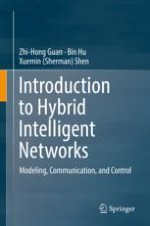2019 | OriginalPaper | Buchkapitel
9. Event-Driven Communication and Control in Multi-Agent Networks
verfasst von : Zhi-Hong Guan, Bin Hu, Xuemin (Sherman) Shen
Erschienen in: Introduction to Hybrid Intelligent Networks
Aktivieren Sie unsere intelligente Suche, um passende Fachinhalte oder Patente zu finden.
Wählen Sie Textabschnitte aus um mit Künstlicher Intelligenz passenden Patente zu finden. powered by
Markieren Sie Textabschnitte, um KI-gestützt weitere passende Inhalte zu finden. powered by
